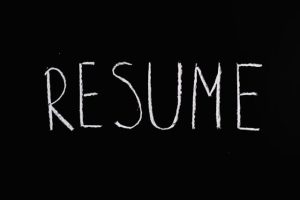The Evolution Of Resumes

Have you ever wondered about the origins of resumes? Nowadays, it’s common knowledge that when searching for a job, having a resume or a CV is the entry point. These documents showcase a person’s professional achievements and are the first impression a recruiter has of an applicant. However, did you know that resumes as we know them today only came into existence 70 years ago? Since the 1950s, they have evolved from a mere formality to a powerful personal marketing tool. Let’s delve into the history and transformation of resumes.
When Was The Resume First Created?
The resume, a document that showcases a person’s work experience, skills, and qualifications, has a surprisingly long history, dating back to around 1482. This early example is attributed to the famous Renaissance figure, Leonardo da Vinci. When Da Vinci sought employment from the Duke of Milan, he penned a letter detailing his diverse talents and accomplishments in engineering, art, and other areas. This letter serves as a precursor to the modern resume, setting the stage for how individuals present their credentials when applying for jobs. Some key points about the origin of resumes include:
- Leonardo da Vinci’s Letter to the Duke of Milan: This historical document is often cited as the earliest example of a resume. In his letter, Da Vinci highlighted his skills in various fields, such as engineering, architecture, and artistic endeavours, to impress potential employers.
- Purpose of Early Resumes: Just like today, the purpose of Da Vinci’s resume was to demonstrate his qualifications and suitability for the position he sought. By outlining his diverse talents and achievements, he aimed to persuade the Duke of Milan to hire him for his exceptional abilities.
- Evolution of Resumes: Over the centuries, resumes have evolved significantly in terms of format, content, and presentation. From handwritten letters to typed documents and, more recently, digital resumes, the format has adapted to changing technological and societal norms.
- Importance of Tailoring: Even in Da Vinci’s time, customising the resume to fit the specific job and audience was crucial. By emphasising relevant skills and experiences, applicants could increase their chances of securing employment, a practice that remains essential in today’s competitive job market.
- Continued Relevance: Despite the advent of online job portals and professional networking platforms, the traditional resume remains a fundamental tool for job seekers worldwide. While its format and delivery methods may continue to evolve, the essence of summarising one’s qualifications and experiences remains unchanged.
So, the origins of the resume can be traced back to Leonardo da Vinci’s letter to the Duke of Milan in 1482. This historical document laid the foundation for the modern resume, emphasising the importance of showcasing relevant skills and experiences to potential employers.
Evolution Of The Resume
Here’s a year-by-year overview of the evolution of resumes from 1930 to 2000:
1930: Resumes were typically simple and consisted of basic information such as name, contact details, education, and work experience.
1935: With the Great Depression, job seekers began to emphasise their skills and accomplishments more prominently to stand out in a competitive job market.
1940: Resumes remained relatively basic, but job seekers increasingly highlighted relevant achievements and experiences.
1945: The end of World War II led to a surge in demand for skilled workers, prompting job seekers to tailor their resumes to specific job roles and industries.
1950: Resumes began to include objective statements, where candidates outlined their career goals and aspirations.
1955: The chronological resume format became popular, listing work experience in reverse chronological order to emphasise career progression.
1960: Resumes continued to evolve with advancements in typewriting technology, allowing for more polished and professional-looking documents.
1965: Candidates started to include references on their resumes, typically former employers or colleagues who could vouch for their qualifications.
1970: The functional resume format gained popularity, emphasising skills and abilities rather than chronological work history.
1975: Resumes began to incorporate more detailed descriptions of job duties and accomplishments, reflecting a greater emphasis on quantifiable achievements.
1980: The rise of desktop publishing enabled candidates to create visually appealing resumes with improved formatting and design elements.
1985: Resumes started to include keywords relevant to the job or industry to increase visibility in electronic resume databases and applicant tracking systems.
1990: With the proliferation of the internet, online job boards and resume databases became popular, changing the way resumes were distributed and accessed.
1995: The use of email for job applications became widespread, leading to the adoption of digital resumes in formats such as Word documents or PDFs.
2000: Resumes continued to evolve with advancements in technology, including the use of multimedia elements such as hyperlinks, videos, and online portfolios.
2005: Social media platforms like LinkedIn emerged as valuable tools for professional networking and job searching, influencing the way resumes were presented and shared online.
Throughout this period, resumes evolved in response to changes in technology, economic conditions, and hiring practices, reflecting the ongoing need for job seekers to effectively communicate their qualifications and experiences to potential employers.
Major Trends In Resumes From 20 Years Ago
- Physical Copies: Resumes were primarily printed on high-quality paper and submitted in person or via postal mail. Digital formats were less common, and online job applications were not as prevalent as they are today.
- Chronological Format: The chronological resume format, listing work experience in reverse chronological order, was the most common format used. This format emphasised a candidate’s career progression and stability.
- Objective Statements: Resumes often included objective statements at the beginning, where candidates briefly outlined their career goals and aspirations. These statements provided context for employers regarding the candidate’s intentions and motivations.
- Emphasis on Hard Skills: Resumes focused heavily on technical skills and qualifications, particularly for technical and specialised roles. Candidates highlighted their proficiency in specific software, tools, and technologies relevant to their field.
- Professional References: It was common for resumes to include a list of professional references, typically former supervisors or colleagues who could vouch for the candidate’s qualifications and work ethic.
- Minimal Design Elements: Resumes tended to be straightforward and simple in design, with minimal use of graphics or formatting. The emphasis was on clear, concise presentation of information, without distractions.
- Lengthier Resumes: Resumes often span multiple pages, especially for candidates with extensive work experience. While there was a preference for brevity, candidates were encouraged to include all relevant experience and achievements.
These trends reflect the conventions and preferences of hiring practices from two decades ago, highlighting the evolution of resume writing and job application strategies over time.
The Golden Age of Resume Writing: The Emergence of Automation
During the early 1980s and 1990s, resume writing experienced its prime. Back then, individuals had the freedom to format their resumes without relying on professional writers. The accessibility of personal computers made it possible for people to create professional and Standardised resumes effortlessly. However, despite the ease of resume writing, job seekers face difficulties in finding job advertisements. Fortunately, the golden age came to an end with the emergence of the Internet and email, which revolutionised the job market by making job ads visible to everyone.
Once upon a time, there existed a handy tool that made hidden job ads accessible to everyone. As a result, the art of crafting resumes gained immense popularity. This surge in resume writing led to a flood of applications being sent to employers. Unfortunately, the ease of emailing resumes also meant that employers were bombarded with an overwhelming number of applications for a single job position. Consequently, only a small fraction, roughly two out of ten, were read. To tackle this issue, software was developed to streamline the resume screening process. This ingenious tool digitally sifted through the multitude of resumes, narrowing them down to a manageable number that could be easily reviewed by humans.
The Applicant Tracking Software (ATS) was a software developed by employers to manage the overwhelming amount of resumes they received. Its main purpose was to identify specific keywords. Resumes that didn’t have these keywords were filtered out. However, the initial version of the ATS software had some flaws, which made it unable to handle certain types of documents like PDFs, resumes with serif fonts, and those containing graphics.
7 Resume Trends You Need to Know
Here are seven resume trends that are prevalent in today’s job market:
- Digital Formats: With the rise of online job applications and digital recruitment platforms, resumes are commonly submitted electronically as PDFs or Word documents. This allows for easy sharing, storage, and customisation.
- Customisation And Tailoring: Rather than using a one-size-fits-all approach, modern resumes are often tailored to specific job postings and companies. Candidates highlight relevant skills, experiences, and keywords to match the requirements of each position.
- Summary or Profile Statement: Many resumes now include a summary or profile statement at the beginning, providing a brief overview of the candidate’s skills, experiences, and career objectives. This section serves as a snapshot of the candidate’s qualifications and helps to capture the recruiter’s attention quickly.
- Skills-Based Sections: In addition to traditional work experience listings, resumes often feature a separate section dedicated to key skills and competencies. This allows candidates to showcase their proficiency in relevant areas, such as technical skills, soft skills, and industry-specific knowledge.
- Visual Elements: While content remains the priority, modern resumes may incorporate subtle visual elements, such as icons, borders, or color accents, to enhance readability and visual appeal. However, it’s essential to maintain a professional and minimalist design aesthetic.
- LinkedIn Integration: Many candidates include a link to their LinkedIn profile on their resumes, allowing recruiters to explore their professional background in more detail. This integration provides additional context and credibility to the candidate’s qualifications.
- Quantifiable Achievements: Rather than simply listing job duties, modern resumes emphasise quantifiable achievements and results. Candidates use specific metrics, percentages, or figures to demonstrate the impact of their contributions in previous roles, showcasing their value to potential employers.
These trends reflect the evolving expectations of recruiters and hiring managers in today’s competitive job market, emphasising the importance of customisation, digital proficiency, and concise communication of qualifications.
Modern Resource For Finding Applicants
One modern resource for finding applicants is professional networking platforms, such as LinkedIn. These platforms allow recruiters to search for candidates based on specific criteria, such as skills, experience, and location. Additionally, candidates often maintain detailed profiles showcasing their professional background, skills, endorsements, and recommendations, making it easier for recruiters to identify potential candidates. Other modern resources include:
Online Job Boards
Websites like Indeed, Glassdoor, and Monster allow recruiters to post job openings and search for candidates who have uploaded their resumes or profiles. These platforms often offer advanced search filters and applicant tracking systems to streamline the recruitment process.
Social Media
Social media platforms like Twitter, Facebook, and Instagram can also be used to attract and engage with potential candidates. Recruiters can leverage targeted advertising, content marketing, and networking to reach a broader audience of job seekers.
Referral Programmes
Many companies have referral Programmes where current employees can recommend candidates for open positions. Referrals tend to be high-quality candidates who are a good cultural fit for the organisation, making this an effective and cost-efficient recruitment strategy.
Recruitment Software
Applicant tracking systems (ATS) and recruitment software help streamline the hiring process by automating tasks such as resume screening, candidate communication, and interview scheduling. These tools often include features like resume parsing, candidate scoring, and analytics to optimise recruitment efforts.
Freelance Platforms
For project-based or temporary roles, freelance platforms like Upwork, Freelancer, and Fiverr can be valuable resources for finding skilled contractors and freelancers. These platforms allow recruiters to post project descriptions, review proposals, and collaborate with freelancers remotely.
Networking Events and Conferences
Industry-specific networking events, conferences, and career fairs provide opportunities for recruiters to meet potential candidates face-to-face and build relationships within their professional community. These events can be particularly effective for recruiting passive candidates who may not be actively looking for new opportunities.
By leveraging these modern resources, recruiters can expand their candidate pool, streamline their recruitment process, and attract top talent to their organisations.
How Mentoria Can Help
Resumes have come a long way in the past century. They used to be simple paper profiles, but now they have become dynamic multimedia selling tools. Instead of just focusing on pedigree, resumes now highlight skills, achievements, and personal branding.
Understanding this history helps us understand how resumes look today. It also reminds us that resumes will continue to change as times change. Just like social media and computers revolutionised traditional practices, new technologies will bring about even more transformations.
By keeping up with these resume trends, being adaptable, and tailoring our experiences to meet the requirements, we can make a strong first impression on potential employers. While formats may differ, one thing remains the same: a compelling resume can open doors to new opportunities in any era.
Mentoria’s personalised career guidance can serve as your guiding light. With Mentoria’s career guidance programme, you have the opportunity to explore and select the ideal path from a wide range of 3 streams, over 850 courses, and more than 12,000 careers. Uncover what truly brings out your potential with Mentoria.












